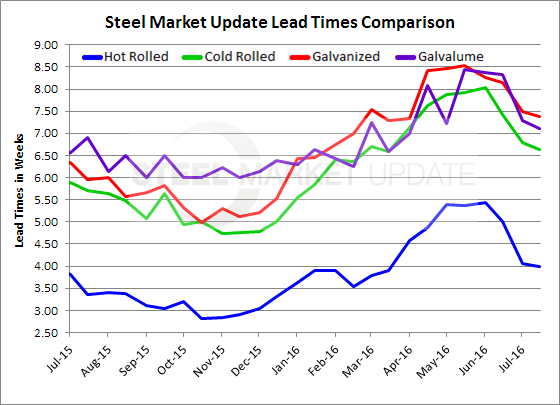SMU Data and Models

Trend Developing as Steel Mill Lead Times Slip
Written by John Packard
July 24, 2016
We pointed out a couple of weeks back that lead times have been slowly shrinking but are still longer than year ago levels. Lead times refer to the amount of time it takes to get an order placed today produced at one of the domestic steel mills.
The steel mill lead times we are discussing in this article are based on the cumulative average based on responses collected from all of the manufacturers and service centers who participated in our flat rolled steel trends analysis (survey) this past week. For specific mill lead times, buyers should contact their steel mill representative or rely upon the lead time sheets produced by your steel suppliers.
Hot rolled lead times are averaging 4.0 weeks, essentially unchanged from our early July analysis (4.07 weeks). At the beginning of June HRC lead times peaked at 5.43 weeks. One year ago HRC lead times were 3.37 weeks.
Cold rolled lead times also were essentially unchanged at 6.63 weeks versus the 6.79 weeks measured at the beginning of July. As with hot rolled, cold rolled lead times peaked the first week of June at 8.04 weeks. One year ago CRC lead times were reported to be averaging less than 6.0 weeks (5.71 weeks).
Galvanized lead times slipped slightly to 7.38 weeks from 7.50 weeks. The peak for GI lead times was during the month of May when they were averaging 8.5 weeks. They have been slowly slipping ever since. One year ago lead times were about 6.0 weeks (5.95 weeks).
Galvalume lead times also slipped a tiny bit from 7.29 weeks at the beginning of the month to 7.11 weeks. The peak of the cycle was achieved during the middle of May at 8.44 weeks.
Lead times are one of the best indicators as we strive to understand the strength of the market and what direction prices are most likely to move from here. At this time, Steel Market Update has our Price Momentum Indicator at Neutral suggesting momentum for prices is not clearly defined and that they could move in either direction (+/- $20/ton) over the next 30 days.
A side note: The data for both lead times and negotiations comes from only service center and manufacturer respondents. We do not include commentary from the steel mills, trading companies, or toll processors in this particular group of questions.
To see an interactive history of our Steel Mill Negotiations data, visit our website here.

John Packard
Read more from John PackardLatest in SMU Data and Models

SMU Scrap Survey: Sentiment Indices rise
Both current and future scrap sentiment jumped this month, though survey participants reported responses before key trade news was announced.

SMU Survey: Sentiment splits, buyers have better view of future than the present
SMU’s Steel Buyers’ Sentiment Indices moved in opposite directions this week. After rebounding from a near five-year low in late June, Current Sentiment slipped again. At the same time, Future Sentiment climbed to a four-month high. Both indices continue to show optimism among buyers about their company’s chances for success, but suggest there is less confidence in that optimism than earlier in the year.

SMU scrap market survey results now available
SMU’s ferrous scrap market survey results are now available on our website to all premium members. After logging in at steelmarketupdate.com, visit the pricing and analysis tab and look under the “survey results” section for “ferrous scrap survey” results. Past scrap survey results are also available under that selection. If you need help accessing the survey results […]

SMU flat-rolled market survey results now available
SMU’s latest steel buyers market survey results are now available on our website to all premium members. After logging in at steelmarketupdate.com, visit the pricing and analysis tab and look under the “survey results” section for “latest survey results.” Past survey results are also available under that selection. If you need help accessing the survey results, or if […]

SMU Survey: Sheet lead times stabilize, plate contracts
Mill lead times for sheet products were steady to slightly longer this week compared to our late June market check, while plate lead times contracted, according to steel buyers responding to this week’s market survey.

